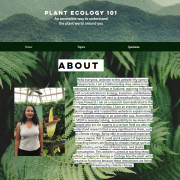Hope Is Not a Strategy – Designing an IDP for a graduate program
Written by Laura Klasek as part of the ASPB Conviron Scholars Program
“This is my favorite part of the research,” said the graduate student supervising my first rotation, “Because right now, anything is possible: the experiment worked, didn’t work, did something unexpected…” We stood in pitch-blackness in the darkroom while film developer rattled, about to spit out the results of my first graduate school experiment. That ineffable joy in discovery — and the hope that our discoveries will help feed our world — inspires many a student to pursue a graduate degree in plant science. But when it comes to completing a dissertation project, hope is not a strategy. Posing and answering scientific questions while developing professional skills requires planning and management, and one tool you can use is an Individual Development Plan or IDP.
What is an IDP?
In essence, an IDP is a goal-setting worksheet. IDPs facilitate reflection and communication between the trainee who fills it out and their trainer. An IDP can be a coffee-stained piece of crumpled loose-leaf with “next semester’s goals” scribbled on the top, but many IDPs are formal documents adopted by graduate programs. Their contents vary, but four typical sections are Skills Assessment, Progress Report, Career Goals, and Setting New Goals.
The Skills Assessment worksheet lists skills — for example, “Being productive in an unstructured environment” — grouped into categories like Core Scientific Knowledge, Professional Skills, Leadership, and Management. A student and their trainer independently rate the student’s proficiency at each skill. When I first encountered this worksheet, it looked alarmingly like a report card. However, we’ve found that graduate students are much harder on themselves than their trainers are on them. The skills assessment can both build confidence and identify areas where both the student and trainer agree more effort should be placed.
A Progress Report is a space to reflect on a student’s progress towards goals they set for themselves. These goals of course include the trials and tribulations of the research project, but the progress report should not be limited solely to the bench. Listing all the presentations, proposals, outreach, courses, and other projects documents a student’s accomplishments, an encouraging record when every experiment fails for six straight months. If students met a goal, they should note what contributed to their success: seeking appropriate help? An idea from a paper? If a goal has gone off-track, the student can think about what’s gone wrong and strategize how to get back on track. The IDP keeps track of tricks that boost a student’s productivity and the pitfalls they discover.
While research is always a priority, career development sometimes finds itself shoved to the end of the to-do list with the cobwebs and empty coffee cups. The Career Goals section of the IDP is a time and space to think about what a student’s graduate education is a stepping-stone towards. Some IDPs, like myIDP from AAAS, include information about different career paths and how they match a student’s self-reported skills and values. Discussing career plans with a trainer helps them know what advice to give and resources to point out.
Finally, a student integrates these past, present, and future sections of the IDP — the skills to work on, what worked well and not-so-well for in projects, and the steps taken for your future career — into a new set of goals. Students and trainers discuss these goals, and the goals form a roadmap for the next few months to a year. The new goals are hopefully more attainable than the last because of the reflection, and because the IDP process is iterative, when a student next fills out their IDP, they continue to refine and re-focus on their progress.
Why write an IDP specific for your graduate program?
To be clear: there are existing IDPs available on the internet perfectly adequate for setting goals and facilitating conversations with a trainer about them. However, like snowflakes, every graduate program is distinct. Adapting the general IDP framework more specifically to your program enables you to emphasize the unique aspects of your program’s training.
At UC Davis, professor Julin Maloof had used IDPs with his graduate students and suggested our program might want an IDP. Two graduate students — the pro-IDP Katie Murphy and the skeptic (me) — read dozens of IDPs available online, many of which are collected in the appendix below. Each individual IDP had aspects we liked, but no one available document included everything we wanted. We copied and pasted the best parts into an enormous Frankenstein IDP, and, while winnowing the IDP down, discovered things that were missing. For example, because our graduate program crosses many bureaucratic lines at the university, and every student ends up intersecting departments differently, we included a place to list the appropriate contacts for funding, TAships, paperwork, and emergency resources.
Our rough IDP then underwent extensive beta-testing. Katie and I used the IDP at the end of the 2017-2018 school year and discovered sections that were redundant or less useful than we hoped. The Plant Biology mentorship committee reviewed the IDP and suggested edits, and in the upcoming months, the entire graduate program will have the option of testing the IDP and providing feedback. After a final round of revision, the IDP will be mandatory at the end of the 2019-2020 school year, and the mentorship committee will take charge of reviewing and updating the IDP each year.
If designing your own IDP interests you, at the base of this article is an appendix of many of the IDPs we consulted as well as an outline of the process our program used to design, test, and refine our new IDP.

Appendix
IDPs (including those adapted for UC Davis PBGG document):
- Stanford Biosciences IDP and additional resources: https://biosciences.stanford.e…
- UW-Madison IDP and additional resources: https://grad.wisc.edu/pd/idp/
- Case Western Reserve School of Medicine: http://casemed.case.edu/gradpr…
- Vanderbilt School of Medicine: https://medschool.vanderbilt.e…
- Cornell, Weill Cornell Graduate School of Medical Sciences: https://test-wcm-pharmacology….
- FASEB, Individual Development Plans for Postdoctoral Scholars: http://www.faseb.org/portals/2…
- Yale University, Individual Development Planning: Achieving Higher Performance: https://your.yale.edu/sites/de…
- AAAS myIDP: http://myidp.sciencecareers.or…
- Imagine PhD https://www.imaginephd.com/abo…
- Inside Higher Ed, “Chart Your Course” : https://www.insidehighered.com…
- Vincent BJ et al., (2015). Yearly planning meetings: individualized development plans aren’t just more paperwork. https://www.ncbi.nlm.nih.gov/p…
Career Exploration and Planning
- Plantae career resources: https://plantae.org/careers/
- Articles about career and professional development from AAAS: http://www.sciencemag.org/tags…









Leave a Reply
Want to join the discussion?Feel free to contribute!